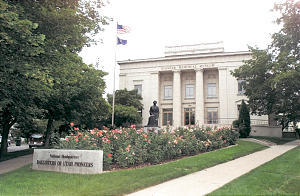Difference between revisions of "Pioneer Memorial Museum"
(Created page with "300px|thumb|right|frame|Courtesy Church News/Stuart Johnson The '''Pioneer Memorial Museum''', also known as the Daughters of Utah Pioneers M...") |
|||
| Line 5: | Line 5: | ||
The museum, and its satellite museums, feature displays and collections of memorabilia from the time the earliest settlers entered the Valley of the Great Salt Lake until the joining of the railroads at a location known as Promontory Point, Utah, on May 10, 1869. | The museum, and its satellite museums, feature displays and collections of memorabilia from the time the earliest settlers entered the Valley of the Great Salt Lake until the joining of the railroads at a location known as Promontory Point, Utah, on May 10, 1869. | ||
| − | According to the DUP website, “The artifacts of the pioneers may surprise you. While the museum displays plenty of necessary objects fashioned out of the scarce resources available in Utah, the pioneers also leave a material record of remarkably ornate decorative arts. They carefully tended their luxury items -- as small and delicate as crystal salters or as large and cumbersome as pianos -- all the way across the continent. The museum displays many of these treasures that reminded them of "home" or their loved ones they were leaving behind. Also, pioneer | + | According to the DUP website, “The artifacts of the pioneers may surprise you. While the museum displays plenty of necessary objects fashioned out of the scarce resources available in Utah, the pioneers also leave a material record of remarkably ornate decorative arts. They carefully tended their luxury items -- as small and delicate as crystal salters or as large and cumbersome as pianos -- all the way across the continent. The museum displays many of these treasures that reminded them of "home" or their loved ones they were leaving behind. Also, pioneer craftsmen were astoundingly adaptable to the materials available in Utah, making gorgeous pine furniture and painting it in a fashion that makes it look like more expensive wood, such as mahogany. Early Utahns also owned some of the finest goods available at the time, brought in either with ox team or by railroad later. From rugged, homemade utilitarian objects to elaborate Victorian decor, you can see the full range of the material record of the resilient pioneers at the Pioneer Memorial Museum.”[http://www.dupinternational.org/dyn_page.php?pageID=11] |
The museum includes a separate carriage house that can be reached via underground passageway. It is full of an original pioneer wagon, sleighs, handcarts, bicycles, a blacksmith shop, and a mule-drawn streetcar. | The museum includes a separate carriage house that can be reached via underground passageway. It is full of an original pioneer wagon, sleighs, handcarts, bicycles, a blacksmith shop, and a mule-drawn streetcar. | ||
Revision as of 14:33, 12 January 2022
The Pioneer Memorial Museum, also known as the Daughters of Utah Pioneers Museum, is located in Salt Lake City near Utah’s State Capitol Building and houses the world’s largest collection of artifacts on one subject.
The museum, and its satellite museums, feature displays and collections of memorabilia from the time the earliest settlers entered the Valley of the Great Salt Lake until the joining of the railroads at a location known as Promontory Point, Utah, on May 10, 1869.
According to the DUP website, “The artifacts of the pioneers may surprise you. While the museum displays plenty of necessary objects fashioned out of the scarce resources available in Utah, the pioneers also leave a material record of remarkably ornate decorative arts. They carefully tended their luxury items -- as small and delicate as crystal salters or as large and cumbersome as pianos -- all the way across the continent. The museum displays many of these treasures that reminded them of "home" or their loved ones they were leaving behind. Also, pioneer craftsmen were astoundingly adaptable to the materials available in Utah, making gorgeous pine furniture and painting it in a fashion that makes it look like more expensive wood, such as mahogany. Early Utahns also owned some of the finest goods available at the time, brought in either with ox team or by railroad later. From rugged, homemade utilitarian objects to elaborate Victorian decor, you can see the full range of the material record of the resilient pioneers at the Pioneer Memorial Museum.”[1]
The museum includes a separate carriage house that can be reached via underground passageway. It is full of an original pioneer wagon, sleighs, handcarts, bicycles, a blacksmith shop, and a mule-drawn streetcar.
Among the collected pieces, the museum displays paintings by noted Utah artists, pioneer portraits, guns, quilts, flags, furniture, books, clothing, samplers, a Conestoga wagon, medical and dental tools, a stagecoach, a 1902 fire engine, sewing machines, the original carved eagle from Eagle Gate, a coach from Yellowstone Park, articles associated with Johnston's Army, the Mormon Battalion, Nauvoo Legion, and the Spanish American War. The museum also has a collection of Victorian hair art.
